中国茶文化中茶名英译探索
中国茶文化英文版完整版剖析

Classification of tea
绿茶
green tea
红茶
black tea
乌龙茶
oolong tea
黄茶
yellow tea
白茶
white tea
黑茶
dark tea
? 红茶black tea
(3)Tea can prevent heatstroke
茶能降温消暑
(4)Tea drinking helps excite center and toning up the ability of doing
sport饮s 茶能刺激中枢神经,增强运动能力。
(5)there are many kinds of vitamins in the tea leaves, They are good for our health.
宁可三天无油盐,不可一日不喝茶
? Eaat rh清lyo晨mm一e杯o.r茶n,in饿g死c卖u药p家of tea, starve sell medicine
一日无茶则滞,三日无茶则病
? A day without tea is lag, the three day without tea is disease.
Chinese tea Culture
中国茶文化
Catalogue
The origin of Chinese tea Classification of tea Some famous tea in China The benefits of tea Summary
The origin of Chinese tea
中国文化走出去背景下《红楼梦》中茶名英译研究
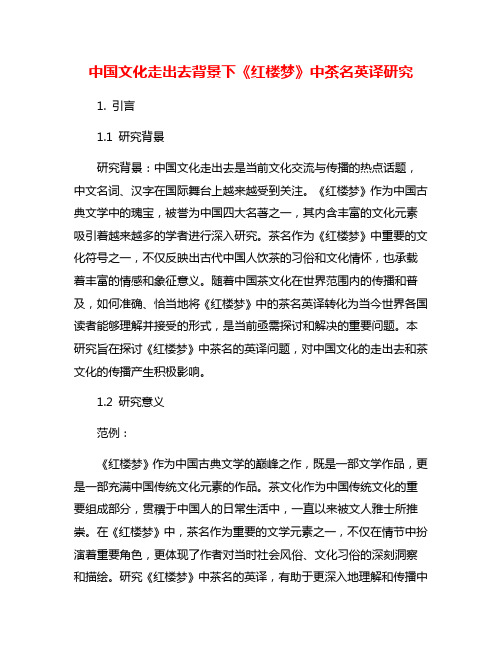
中国文化走出去背景下《红楼梦》中茶名英译研究1. 引言1.1 研究背景研究背景:中国文化走出去是当前文化交流与传播的热点话题,中文名词、汉字在国际舞台上越来越受到关注。
《红楼梦》作为中国古典文学中的瑰宝,被誉为中国四大名著之一,其内含丰富的文化元素吸引着越来越多的学者进行深入研究。
茶名作为《红楼梦》中重要的文化符号之一,不仅反映出古代中国人饮茶的习俗和文化情怀,也承载着丰富的情感和象征意义。
随着中国茶文化在世界范围内的传播和普及,如何准确、恰当地将《红楼梦》中的茶名英译转化为当今世界各国读者能够理解并接受的形式,是当前亟需探讨和解决的重要问题。
本研究旨在探讨《红楼梦》中茶名的英译问题,对中国文化的走出去和茶文化的传播产生积极影响。
1.2 研究意义范例:《红楼梦》作为中国古典文学的巅峰之作,既是一部文学作品,更是一部充满中国传统文化元素的作品。
茶文化作为中国传统文化的重要组成部分,贯穓于中国人的日常生活中,一直以来被文人雅士所推崇。
在《红楼梦》中,茶名作为重要的文学元素之一,不仅在情节中扮演着重要角色,更体现了作者对当时社会风俗、文化习俗的深刻洞察和描绘。
研究《红楼梦》中茶名的英译,有助于更深入地理解和传播中国传统文化,同时也有助于推动中国文化走出去的步伐。
通过对茶名英译的研究,可以进一步挖掘《红楼梦》中茶文化的内涵和外延,探索其中蕴含的人文精神,为中国文化的国际传播提供新的思路和途径。
研究《红楼梦》中茶名的英译具有重要的理论和实践意义。
1.3 研究内容研究内容包括对《红楼梦》中茶名的英译进行系统性整理和分析,探讨茶名在小说中的文化内涵和象征意义。
通过挖掘小说中茶名的描写和运用,解读茶名在人物性格、情节发展等方面的作用,揭示茶文化在小说中的重要地位。
对茶名的英译历史进行梳理和比较,分析不同译者对茶名的翻译取向和策略,并探究这些翻译背后的文化因素和意义。
对现代茶名的英译进行对比分析,探讨不同英文译名对茶名的表达和传达效果,评估其对文化传播的影响。
中国成品茶英译名的失落与复乐
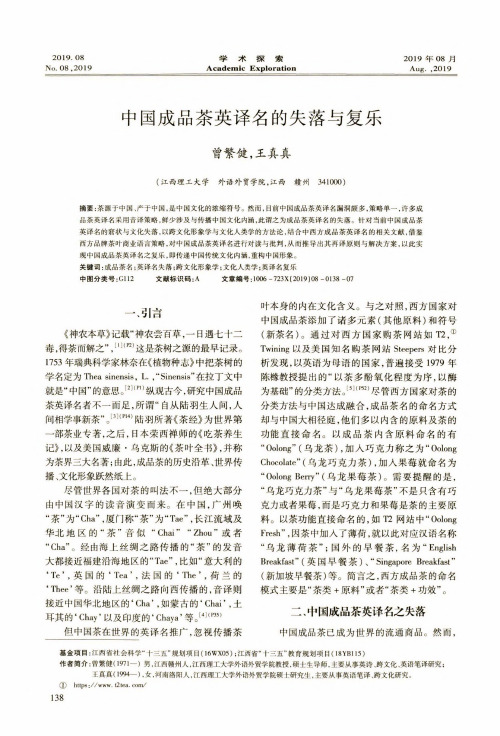
0* ® 策略看似较多样,译名似乎较贴切,但中国内涵
文化仍未传递,对中国形象的建构也毫无益处。 通过选取十二个样本,并抽取中国十大名
茶,共计50个观测值。①统计以成品茶英译名常 用的翻译策略为衡量标准,以文献所采用的英译 名策略次数统计计数,详见表1。
表1中西方中国成品茶英译名翻译策略数据统计表
音直意
Maofeng","普洱茶"译为"Puer/Pu^r tea" o 由上 可知,国内成品茶英译名多采用音译法。
《世界茶叶百科全书》(The World Tea Ency clopaedia) 中国茶》(All the tea in China)和英 国茶专家简・佩蒂格鲁的《茶分类:茶爱好者的
伴侣》(Tea Classified: A Tea lover's Companion)等
尽管世界各国对茶的叫法不一,但绝大部分 由中国汉字的读音演变而来。在中国,广州唤 “茶”为“Cha”,厦门称“茶”为“Tae”,长江流域及 华北地区的“茶”音似“Chai” “Zhou ”或者 “Cha”。经由海上丝绸之路传播的“茶”的发音 大都接近福建沿海地区的“Tae”,比如“意大利的 'Te ',英国的'Tea ',法国的’The 荷兰的 'Thee,等。沿陆上丝绸之路向西传播的,音译则 接近中国华北地区的'Cha',如蒙古的’Chai',土 耳其的'Chay'以及印度的'Chaya'等。⑷
2019. 08 No. 08,2019
学术探索 Academic Exploration
2019年08月 Aug. ,2019
中国成品茶英译名的失落与复乐
探索中国茶文化英语作文
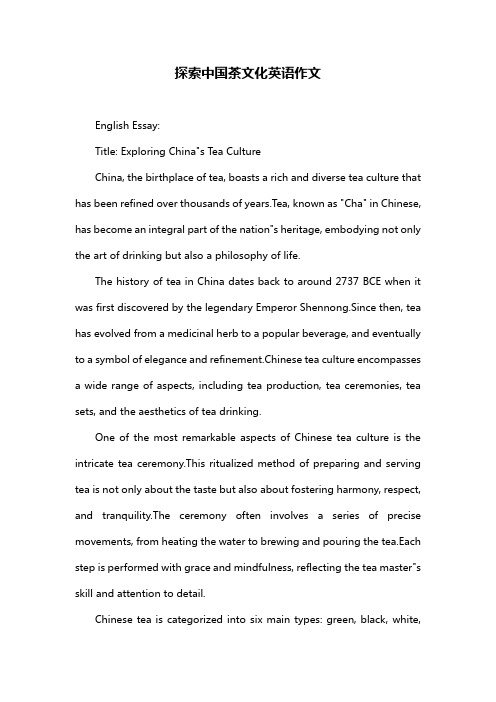
探索中国茶文化英语作文English Essay:Title: Exploring China"s Tea CultureChina, the birthplace of tea, boasts a rich and diverse tea culture that has been refined over thousands of years.Tea, known as "Cha" in Chinese, has become an integral part of the nation"s heritage, embodying not only the art of drinking but also a philosophy of life.The history of tea in China dates back to around 2737 BCE when it was first discovered by the legendary Emperor Shennong.Since then, tea has evolved from a medicinal herb to a popular beverage, and eventually to a symbol of elegance and refinement.Chinese tea culture encompasses a wide range of aspects, including tea production, tea ceremonies, tea sets, and the aesthetics of tea drinking.One of the most remarkable aspects of Chinese tea culture is the intricate tea ceremony.This ritualized method of preparing and serving tea is not only about the taste but also about fostering harmony, respect, and tranquility.The ceremony often involves a series of precise movements, from heating the water to brewing and pouring the tea.Each step is performed with grace and mindfulness, reflecting the tea master"s skill and attention to detail.Chinese tea is categorized into six main types: green, black, white,yellow, oolong, and pu"er.Each type has its unique characteristics, production methods, and health benefits.For instance, green tea is known for its refreshing taste and high antioxidant content, while pu"er tea is famous for its aged flavor and ability to improve digestion.Moreover, the appreciation of tea extends beyond the taste and aroma.The act of drinking tea is often accompanied by the appreciation of tea sets, which can be made from various materials such as porcelain, clay, or glass.The design and craftsmanship of these sets contribute to the overall tea experience, adding an aesthetic dimension to the ceremony.In modern times, tea houses have become popular social venues where people gather to enjoy a cup of tea while engaging in conversation, playing chess, or simply relaxing.These establishments provide a tranquil escape from the bustling city life, allowing patrons to immerse themselves in the serene atmosphere of tea culture.In conclusion, China"s tea culture is a treasure trove of history, tradition, and aesthetics.It offers a unique blend of sensory pleasure, social interaction, and spiritual enlightenment.Exploring this multifaceted culture is an enriching experience that allows one to appreciate not only the delicate flavors of tea but also the profound wisdom of Chinese philosophy.中文作文:标题:探索中国茶文化中国,茶叶的故乡,拥有丰富多样的茶文化,这一文化经过数千年的沉淀与提炼,已成为国家文化遗产的重要组成部分。
中国茶文化传播视角下的茶名英译
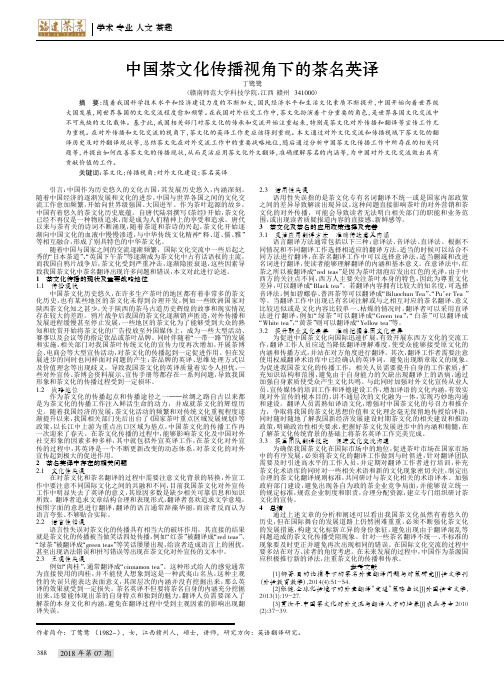
2018年第07期学术专业人文茶趣作者简介:丁鹭鹭(1982-),女,江西赣州人,硕士,讲师,研究方向:英语翻译研究。
引言:中国作为历史悠久的文化古国,其发展历史悠久,内涵深刻。
随着中国经济的逐渐发展和文化的进步,中国与世界各国之间的文化交流工作愈加频繁,开始向世界级强国、大国进军。
作为茶叶起源的故乡,中国有着悠久的茶文化历史底蕴。
自唐代陆羽撰写《茶经》开始,茶文化已经不再仅是一种物质追求,而是成为人们精神上的享受和追求。
唐代以来与茶有关的诗词不断涌现,随着茶道和茶诗的兴起,茶文化开始逐渐向中国文化的血液中慢慢渗透,与中华传统文化精神“释、道、儒、雅”等相互融合,形成了别具特色的中华茶文化。
随着中国与国家之间的交流逐渐频繁,国际文化交流中一些后起之秀的“日本茶道”、“英国下午茶”等逐渐成为茶文化中占有话语权的主流,而我国自鸦片战争后,茶文化受到严重冲击,逐渐隐匿衰退,这些因素导致我国茶文化中茶名翻译出现许多问题和错误,本文对此进行论述。
1茶文化传播的现状及重要战略地位1.1传播现状中国茶文化历史悠久,在许多生产茶叶的地区都有着非常多的茶文化历史,也有某些地区的茶文化未得到合理开发,例如一些欧洲国家对陕西茶文化知之甚少,关于陕西的茶马古道历史辉煌的故事和现实情况存在较大的差距。
鸦片战争后我国的茶文化逐渐销声匿迹,对外传播和发展进程缓慢甚至停止发展,一些地区的茶文化为了能够受到大众的熟知和欣赏开始将茶文化的广告投放至外国媒体上,成为一些大型活动、赛事以及会议等的指定饮品或茶叶品牌。
同时伴随着“一带一路”的发展和实施,相关部门对我国茶叶传统文化的宣传力度再次增加,开展茶博会、电商会等大型宣传活动,对茶文化的传播起到一定促进作用。
但在发展进步的同时也同样面对问题的产生:茶品牌的英译、思维处理方式以及价值理念等出现歧义,导致我国茶文化的英译质量着实令人担忧,一些对外宣传、茶博会资料展示、宣传手册等都存在一系列问题,导致我国形象和茶文化的传播过程受到一定损坏。
中国茶文化,中英双文
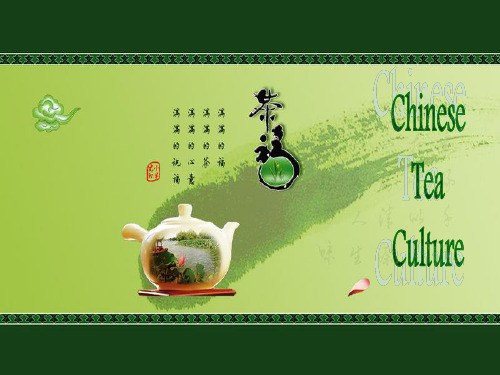
绿茶green 绿茶green tea
Green Yellow White Oolong Dark Black
Tea Tea Tea Tea Tea Tea
low
The degree of fermentation
high
红茶black 红茶black tea
白茶white 白茶white tea
Some useful words and patterns
1.legend:传说, 1.legend:传说,传奇 传说 2.pronunciation: 2.pronunciation:发音 3.classic: 3.classic:经典 4.dialect: 4.dialect:方言 5.character:方块字, 5.character:方块字,汉字 6.legend has it that Shen Nong…was saved when he happened to try some tea leaves.传说中神农在偶然咀嚼了茶叶之后就得救 leaves.传说中神农在偶然咀嚼了茶叶之后就得救 了。 7.“Tea Classic” is widely 的科学著作 recognized as the world’s first
黑 茶
Some famous tea in China
(1)西湖龙井茶 (1)西湖龙井茶 West Lake longjing tea 绿茶 green tea; 中国十大名茶之一 one of the top ten chinese tea, 30多个品牌 30多个品牌 more than 30 brands; 中国政府机构每年都购买超过100kgs的茶叶 中国政府机构每年都购买超过100kgs的茶叶 the central government of china buy more than100kgs every year; (2)洞庭碧螺春茶 (2)洞庭碧螺春茶 Dongting biluochun tea 绿茶 green tea; 中国十大名茶之一 one of the top ten chinese tea; 一个勤劳,善良的孤女,名叫碧螺; 一个勤劳,善良的孤女,名叫碧螺; a hard-working, kind-hearted orphan hardkindgirl, named biluo; 1954年 周总理出席日内瓦会议, 1954年,周总理出席日内瓦会议, 携带2公斤; 携带2公斤; in 1954,premier Zhou attend the Geneva meeting, taking 2kgs;
茶文化视野下“茶”品牌商标的英译策略
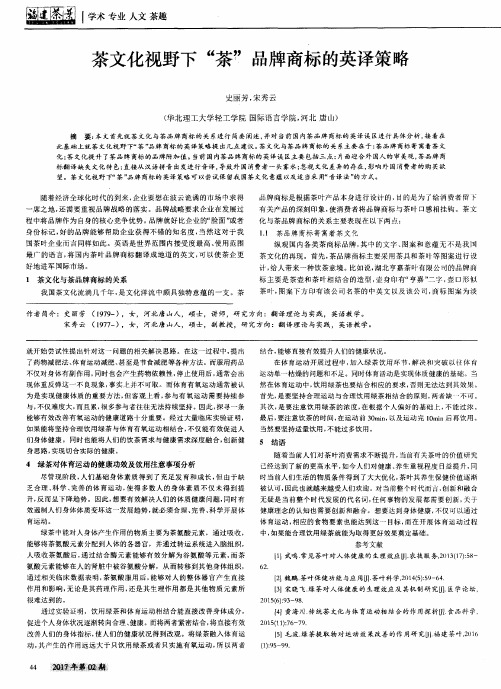
就开始尝试性提 出针对这 一问题的相关解决思路 。在这一过程 中, 提 出 了药物 减肥法、 体 育运动 减肥 、 甚至 是节食减肥等各种方法。而服 用药品 不仅 对身体有副作用 , 同时也会产 生药物 依赖性, 停止使用后 , 通 常会 出 现体重反弹这一不 良现 象, 事实上并不可取 。而体育有氧运动通 常被认
结合 , 能够商接有效提升人们的健康状况。 在 体 育运 动 开 展 过 程 中 , 加入绿茶饮 用环节 , 解 决 和 突 破 以往 体 育 运 动 单 一枯 燥 的 问题 和 不 足 。同时 体 育 活 动 是 实 现 体质 健 康 的基 础 。当 然在 体 育运 动 中 , 饮 用 绿 茶 也 要 结 合 相 应 的要 求 , 否则 无 法 达 到 其 效 果 。 首先, 是 要 坚 持 合 理 运 动 与 合 理 饮 用 绿 茶 相 结 合 的原 则 , 两者 缺 ‘ 不可。 其次 , 是 要 注 意 饮 用 绿 茶 的浓 度 , 在 根 据 个 人 偏 好 的 基 础 , 不能过 浓。 最后 , 要 注 意 饮 茶 的时 间 , 在运动前 3 0 m i n , 以及运动完 l O mi n后 再饮 用 。 当然 要 坚持 适 量 饮 直接从汉语拼音 出发进行音译 , 导致外国消费者一 头雾水: 忽视文化 差异的存在, 影响外 国消 费者的购买欲 望 。茶 文 化视 野 下“ 茶” 品 牌 商 标 的 英 译 策 略 可 以尝 试 保 留我 国 茶 文化 意 蕴 以 及适 当采 用“ 音译 法” 的方式。
此 基础 上 就 萘 文化 视 野 下“ 茶” 品 牌 商 标 的 英 译 策 略提 出 几 点 建议 。 茶 文 化 与 茶 品 牌 商标 的 关 系主 要 在 于 : 茶 品 牌 商 标 寄 寓 着萘 文 化; 茶 文化 提 升 了荼 品牌 商标 的 品 牌 附 加 值 。当前 国 内茶 品 牌 商 标 的 英 译 误 区 主 要 包括 三 点 : 片 面迎 合 外 国人 的 审 美 观 , 茶 品 牌 商
基于中英文化差异的茶叶商标翻译探讨
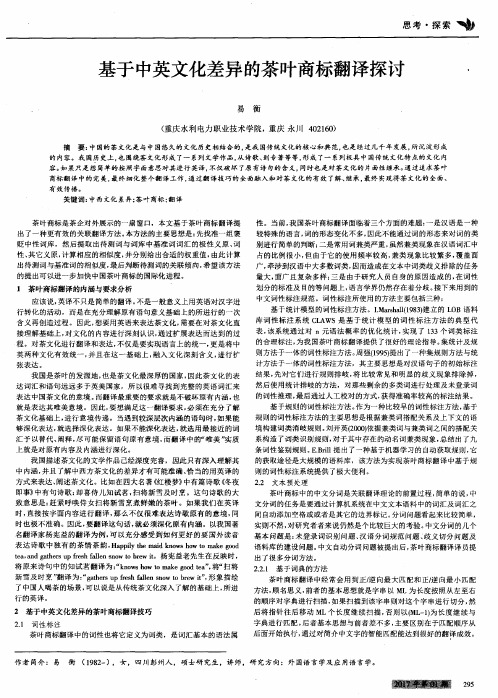
Hale Waihona Puke 性、 其 它义原 , 计 算相应 的相似度 , 并分别给 出合适 的权 重值 , 由此 计算 出待 测词与基 准词的相 似度 , 最后判断 待测 词的关联 倾向 , 希 望该 方法 的提 出可 以进 ~步加快 中国茶叶 商标的 国际化进程 。 1 茶叶 商标翻译 的内涵 与要求分析 应 该说 , 英译 不只是 简单的翻译 。 不是一般 意义上用英 语对汉字进 行转化 的活动 ,而是在充 分理解原 有语句意义 基础上 的所 进 行的一 次 含 义再创 造过程 。因此 , 想 要用英语来 表达茶文 化 , 需要在 对 茶文化直 接 理解基 础上 , 对 文化的 内容进行深 刻认识 , 通 过扩 展表 达而达 到 的过 程 。对茶文 化进行翻 译和表达 , 不仅是 要实现语 言上的统 一, 更 是将中 英 两种 文化有 效统一 , 并且 在这 一基础 上 , 融入文 化 深刻含 义 , 进 行扩
茶文化 基础上 , 进行意境 传递 。当遇到较深层 次内涵; 的语句1 日 寸 , 如 果能 够深化 表达 , 就 选择深化 表达 。如 果不能深化 表达, 就选 用最 接近的 词 汇予 以替代 、 阐释 , 尽 可 能保 留语 句 原有 意境 , 而翻译 中的 唯美 实质 上就是对 原有 内容及 内涵 进行深化 。 我 国描述 茶文化的 文学作 品已经 深度完 善,因此 只有深入理 解其 中 内涵 , 并且 了解 中西方茶 文化的差 异才有可 能准 确 、 恰 当的用 英译 的 方式来表达 、 阐述茶文 化 。比如在 四大名 著 《 红楼 梦》 中有 篇诗歌 《 冬夜 即事》 中有句诗 歌 : 却 喜侍 儿知试 茗 , 扫 将新 雪及 时烹 。这句 诗歌 的大 致 意思是 : 赶 紧呼唤侍 女 扫将新 雪烹 煮鲜嫩 的茶 叶 。如 果我 们在 英译 时, 直接 按字面 内容进 行翻 译, 那 么不仅 很难 表达 诗歌原 有的 意境 , 同 时 也极不 准确 。因此 , 要翻译这 句话 , 就必 须深 化原 有内涵 。以我 国著 名翻 译家杨 宪益 的翻译 为例 . 可 以充分感 受到 如 何更好 的要 国外读 者 表达 诗 歌 中独有 的茶 情 茶韵 , H a p p i l y t h e m a i d k n o w s h o w t o m a k e g o o d t e a , a n d g a t h e r s u p f r e s h f a l l e n s n o w t o b r e w i t 。杨宪 益老先生在 反映时 , 将原 来诗句 中的知 试茗翻 译为 : “ k n o w s h o w t o m a k e g o o d t e a ” , 将“ 扫将 新雪及 时 烹 ” 翻 译为 : “ g a t h e r s u p f r e s h f a l l e n S  ̄ I O W t o b r e w i t ” , 形 象描绘 了中 国人喝茶的场 景, 可 以说是从传统 茶文化深 入 了解 的基础上 , 所进 行的英译 。
中国文化走出去背景下《红楼梦》中茶名英译研究

中国文化走出去背景下《红楼梦》中茶名英译研究
茶在《红楼梦》中代表了文化和艺术的精髓。
茶具有温润舒适、清新悠闲的特点,与
江南文化的细腻和深沉相契合。
茶名的英译应该能够传达出茶的美好氛围和情感意义。
《红楼梦》中常出现的“香片”,可以译为“Fragrant Slice”,这个译名既表达了茶香
的美味和片的形状,也能让英语读者感受到江南文化的柔和和艺术感。
茶在《红楼梦》中也承载了人物的情感和社会关系。
茶作为人们日常生活中的重要组
成部分,与亲友相聚、交谈心事时常常有配套。
《红楼梦》中的“石兰”,可以译为“Stonen Orchid”,这个译名与英语读者能够更好地理解人物情感和交流的背景。
茶还能够体现出人物的性格特点和社会地位。
不同的人有不同的喜好,选择不同的茶
来表现人物性格也是一种常见手法。
《红楼梦》中的“如意香饼”,可以译为“Lucky Fragrant Cake”,这个译名既表达了人物对茶的喜好,还突出了其身份地位和个性特点。
中国文化走出去背景下对《红楼梦》中茶名进行英译研究是一项非常有意义的任务。
通过寻找合适的英语词汇和表达方式,能够更好地将茶的文化和情感意义传达给国际友人,促进中西方文化的交流与合作。
这样的研究不仅有利于提升《红楼梦》在国际上的影响力,也有助于增进世界各国读者对中国文化的了解和认同。
中国文化走出去背景下《红楼梦》中茶名英译研究
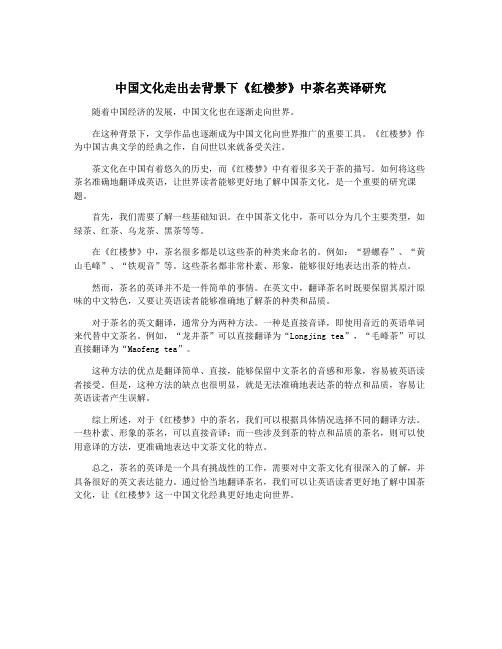
中国文化走出去背景下《红楼梦》中茶名英译研究随着中国经济的发展,中国文化也在逐渐走向世界。
在这种背景下,文学作品也逐渐成为中国文化向世界推广的重要工具。
《红楼梦》作为中国古典文学的经典之作,自问世以来就备受关注。
茶文化在中国有着悠久的历史,而《红楼梦》中有着很多关于茶的描写。
如何将这些茶名准确地翻译成英语,让世界读者能够更好地了解中国茶文化,是一个重要的研究课题。
首先,我们需要了解一些基础知识。
在中国茶文化中,茶可以分为几个主要类型,如绿茶、红茶、乌龙茶、黑茶等等。
在《红楼梦》中,茶名很多都是以这些茶的种类来命名的。
例如:“碧螺春”、“黄山毛峰”、“铁观音”等。
这些茶名都非常朴素、形象,能够很好地表达出茶的特点。
然而,茶名的英译并不是一件简单的事情。
在英文中,翻译茶名时既要保留其原汁原味的中文特色,又要让英语读者能够准确地了解茶的种类和品质。
对于茶名的英文翻译,通常分为两种方法。
一种是直接音译,即使用音近的英语单词来代替中文茶名。
例如,“龙井茶”可以直接翻译为“Longjing tea”,“毛峰茶”可以直接翻译为“Maofeng tea”。
这种方法的优点是翻译简单、直接,能够保留中文茶名的音感和形象,容易被英语读者接受。
但是,这种方法的缺点也很明显,就是无法准确地表达茶的特点和品质,容易让英语读者产生误解。
综上所述,对于《红楼梦》中的茶名,我们可以根据具体情况选择不同的翻译方法。
一些朴素、形象的茶名,可以直接音译;而一些涉及到茶的特点和品质的茶名,则可以使用意译的方法,更准确地表达中文茶文化的特点。
总之,茶名的英译是一个具有挑战性的工作,需要对中文茶文化有很深入的了解,并具备很好的英文表达能力。
通过恰当地翻译茶名,我们可以让英语读者更好地了解中国茶文化,让《红楼梦》这一中国文化经典更好地走向世界。
中国茶文化英译研究的目的和意义
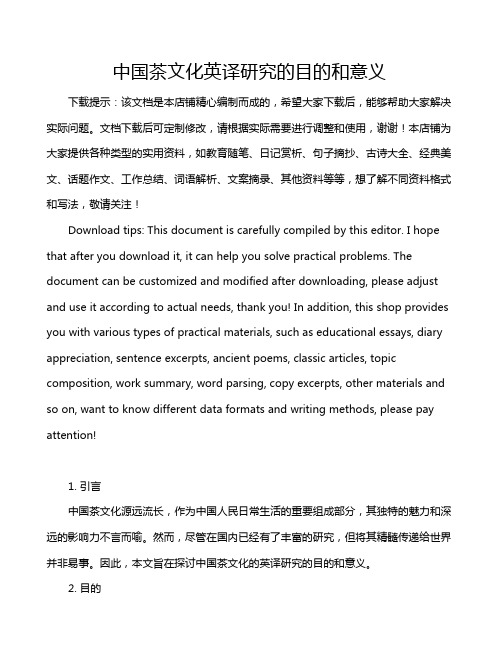
中国茶文化英译研究的目的和意义下载提示:该文档是本店铺精心编制而成的,希望大家下载后,能够帮助大家解决实际问题。
文档下载后可定制修改,请根据实际需要进行调整和使用,谢谢!本店铺为大家提供各种类型的实用资料,如教育随笔、日记赏析、句子摘抄、古诗大全、经典美文、话题作文、工作总结、词语解析、文案摘录、其他资料等等,想了解不同资料格式和写法,敬请关注!Download tips: This document is carefully compiled by this editor. I hope that after you download it, it can help you solve practical problems. The document can be customized and modified after downloading, please adjust and use it according to actual needs, thank you! In addition, this shop provides you with various types of practical materials, such as educational essays, diary appreciation, sentence excerpts, ancient poems, classic articles, topic composition, work summary, word parsing, copy excerpts, other materials and so on, want to know different data formats and writing methods, please pay attention!1. 引言中国茶文化源远流长,作为中国人民日常生活的重要组成部分,其独特的魅力和深远的影响力不言而喻。
中国茶文化(中英双语)
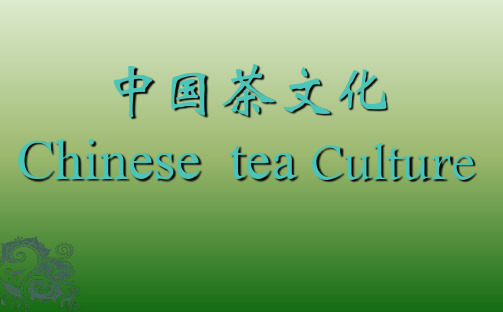
Tea
小结:
几千年来中国不但积累了大量关于茶叶种植、生产 的物质文化、更积累了丰富的有关茶的精神文化, 这就是中国特有的茶文化,属于文化学范畴。
Summary: For thousands of years China has not only accumulated a great deal about tea cultivation, production of material culture, but also accumulated rich spirit of the tea culture, which is unique to China's tea culture, a cultural study areas.
(2)洞庭碧螺春茶
Dongting biluochun tea
•绿茶 green tea; •中国十大名茶之一 one of the top ten chinese tea; •一个勤劳,善良的孤女,名叫碧螺; a hard-working, kind-hearted orphan girl, biluo.
绿茶; 红茶;
3.茶的分类 Classification of tea
green tea;
black tea;
乌龙茶; oolong tea; 黄茶; yellow tea;
绿茶green tea
Байду номын сангаас
白茶;
white tea;
黑茶;
dark tea (heicha);
红茶black tea
黄茶yellow tea
可以说,中国是茶的故乡,茶已成为国饮。
We can say, China is the homeland of tea, and tea have become the national drink.
中国茶文化英译研究
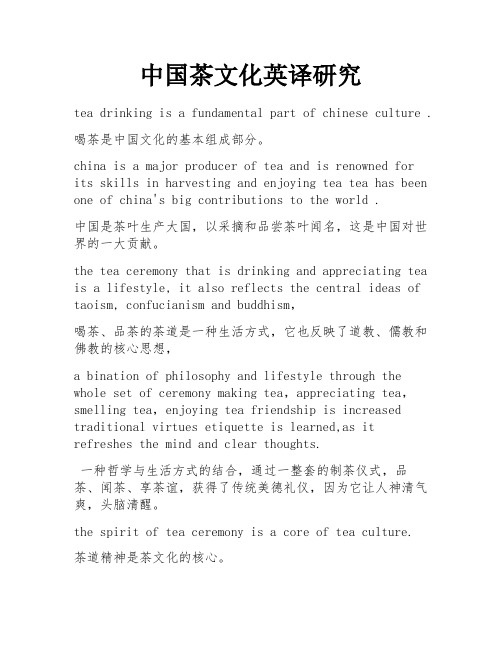
中国茶文化英译研究tea drinking is a fundamental part of chinese culture .喝茶是中国文化的基本组成部分。
china is a major producer of tea and is renowned for its skills in harvesting and enjoying tea tea has been one of china's big contributions to the world .中国是茶叶生产大国,以采摘和品尝茶叶闻名,这是中国对世界的一大贡献。
the tea ceremony that is drinking and appreciating tea is a lifestyle, it also reflects the central ideas of taoism, confucianism and buddhism,喝茶、品茶的茶道是一种生活方式,它也反映了道教、儒教和佛教的核心思想,a bination of philosophy and lifestyle through the whole set of ceremony making tea,appreciating tea,smelling tea,enjoying tea friendship is increased traditional virtues etiquette is learned,as it refreshes the mind and clear thoughts.一种哲学与生活方式的结合,通过一整套的制茶仪式,品茶、闻茶、享茶谊,获得了传统美德礼仪,因为它让人神清气爽,头脑清醒。
the spirit of tea ceremony is a core of tea culture.茶道精神是茶文化的核心。
you may have heard of many kinds of tea,but in general they can be divided into six categories according to the degree of fermentation and the prehensive method,你可能听说过很多种茶,但大体上可以根据发酵程度和综合方法分为六大类,green tea,black tea,oolong tea,dark tea,whitetea ,yellow tea.绿茶,红茶,乌龙茶,红茶,白茶和黄茶。
中国文化走出去背景下《红楼梦》中茶名英译研究

中国文化走出去背景下《红楼梦》中茶名英译研究随着中国文化走出去的步伐加快,中国文学作品在国际舞台上也备受关注,其中包括《红楼梦》,这部经典文学作品不仅在中国深受喜爱,也在国际上拥有相当的影响力。
在《红楼梦》中,茶名是一个重要的文化符号,它承载了中国茶文化的丰富内涵,同时也反映了中国文化的独特魅力。
本文将对《红楼梦》中的茶名进行英译研究,探讨其中所蕴含的文化意义及其在中国文化走出去背景下的重要性。
一、《红楼梦》中的茶名及其文化意义《红楼梦》是中国古典小说的经典之作,自问世以来一直备受推崇。
在这部小说中,茶名被广泛运用,不仅仅是作为饮品的名称,更蕴含了丰富的文化内涵。
茶名在《红楼梦》中既是一种物质存在,同时也是一种精神象征,它承载着作者对中国传统文化的热爱和对生活美好的向往。
茶名在《红楼梦》中多次出现,例如“碧螺春”、“黄山毛峰”、“铁观音”等。
这些茶名都是来自于中国茶文化中的名优茶,它们不仅具有独特的品质和口感,更承载了对自然的敬畏和对生活的热爱。
这些茶名所蕴含的文化意义也丰富多彩,如“碧螺春”代表了春天的气息和清新的品质,“黄山毛峰”则反映了中国山水之间的宁静和优美,“铁观音”则寓意了坚韧和坚固。
由于《红楼梦》是一部经典文学作品,其英译本的出现使得中国文化更加全面地展现在世界读者面前。
茶名的英译却是一个具有挑战性的问题,因为茶名不仅仅是一种名称,更是一种文化符号。
如何将茶名准确地传达给国际读者,成为了翻译工作者们需要认真思考的问题。
在中国文化走出去的背景下,《红楼梦》中茶名的英译更显重要,它不仅仅是一种文学作品的翻译,更是一种文化的传承和传播。
通过英译茶名,可以让国际读者更好地了解中国的茶文化和中国传统文化,同时也可以增进中外文化的交流和理解,促进世界各国间的文化互鉴和交流。
中国茶文化英语
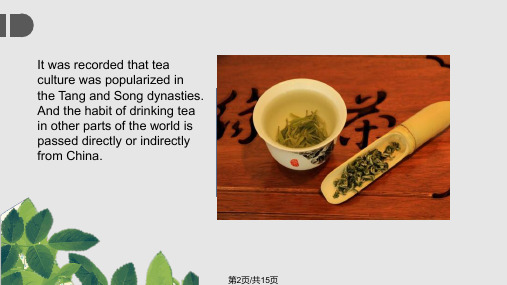
②Biluochun Tea (碧螺春)
●Green tea
●One of the ten famous tea in China
●Biluochun tea has a history of over 1000 years
●And there's a legend about the biluo girl。
Green Tea 绿茶
white tea 白茶
Black Tea 红茶
Oolong Tea 乌龙茶
yellow tea 黄茶
Dark tea 黑茶
第4页/共15页
①West Lake Longjing Tea (西湖龙井茶) ▲Green tea ▲One of the ten famous tea in China ▲Longjing tea is produced in Longjing village, West Lake, Hangzhou, Zhejiang Province
第7页/共15页
④Anxi Tieguanyin Tea (安溪铁观音) ★Tieguanyin is the best product of Oolong tea, which is a unique Chinese tea category. ★From Anxi County, Fujian Province ★Anxi tieguanyin, appeared in World Expo, Shanghai with "the first of the ten famous tea in China"
感谢您的观看!
第15页/共15页
It was recorded that tea culture was popularized in the Tang and Song dynasties. And the habit of drinking tea in other parts of the world is passed directly or indirectly from China.
茶文化与茶名翻译
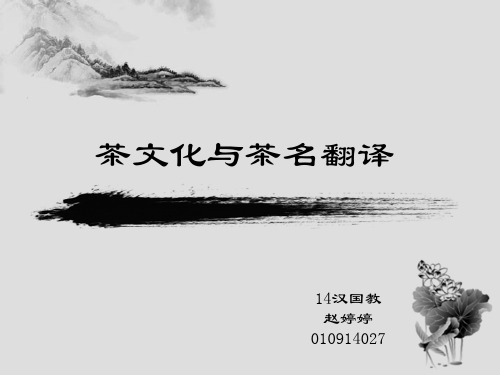
茶名翻译分析
翻译方法 三、厚译法
例:——以历史背景与文化史实命名
“普陀佛茶” “西施银芽” “八仙云雾” “文君绿茶” “东坡毛尖”
WenJunGreenTea(WenJun is a talented female in ancient China)
不仅使得茶叶名称由来以及历史蕴意得到了再现, 在茶叶外销过程中,对于中国的文化外传也能够起重 要作用。
“西湖”采用意译 “龙井”则用音译
茶名翻译分析
翻译方法 二、通用译法
例:——以地名或山名来命名 “韶山韶峰” “南岳云雾” “祁门红茶” “金竹云峰茶” 不能为求便利,纯粹的采用拼音,使得茶叶出产的 地方、区域文化在外译的过程中消失殆尽。采用通 用译法,在推广过程中,通过茶名就能溯其源头, 探索其背后的地方文化。
茶名翻译分析
表达品质特点,如茶类品种、造型、色泽、滋味、香气 (佛手,三杯香等)
茶 叶 的 命 名
显示地方特色,表达强烈的地方、地域性 (西湖龙井,庐山云雾茶等) 表达文化特色,暗示历史背景和文化史实 (文君绿茶、普陀佛茶等) 以物喻名 (遂昌银猴,竹筒香茶等)
茶名翻译仍未统一
茶名翻译分析
Bohea rock tea
正名、立目
Blacktea/Redtea
【英】李约瑟(Dr. Jo-sephNeedham)
——《中国科学技术史》(2000)
正名、立目
作为茶叶起源国以及茶类最 丰富的国度,我国在输出茶文化 的过程中,理应肩负起“正名” 与“分类”的重任,在茶名翻译 过程中不能采用“西方为中心” 的归化译法,这种译法使得茶叶 在国际上分类混乱,范式不通, 使得国内的其他茶叶一直在茶叶 交流与传播的舞台中处于边缘地 位。
中国文化走出去背景下《红楼梦》中茶名英译研究
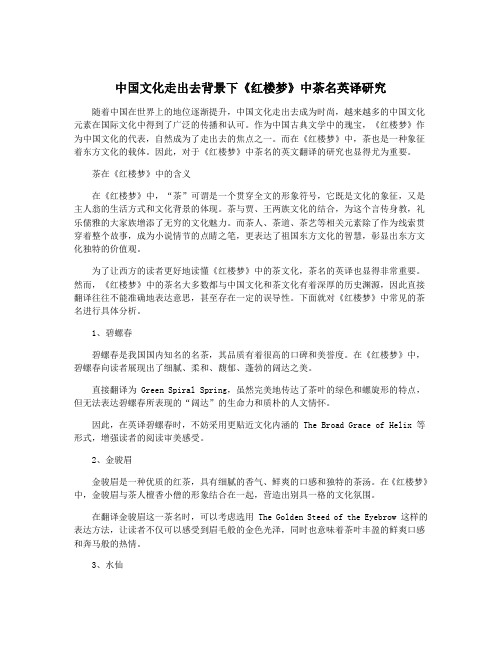
中国文化走出去背景下《红楼梦》中茶名英译研究随着中国在世界上的地位逐渐提升,中国文化走出去成为时尚,越来越多的中国文化元素在国际文化中得到了广泛的传播和认可。
作为中国古典文学中的瑰宝,《红楼梦》作为中国文化的代表,自然成为了走出去的焦点之一。
而在《红楼梦》中,茶也是一种象征着东方文化的载体。
因此,对于《红楼梦》中茶名的英文翻译的研究也显得尤为重要。
茶在《红楼梦》中的含义在《红楼梦》中,“茶”可谓是一个贯穿全文的形象符号,它既是文化的象征,又是主人翁的生活方式和文化背景的体现。
茶与贾、王两族文化的结合,为这个言传身教,礼乐儒雅的大家族增添了无穷的文化魅力。
而茶人、茶道、茶艺等相关元素除了作为线索贯穿着整个故事,成为小说情节的点睛之笔,更表达了祖国东方文化的智慧,彰显出东方文化独特的价值观。
为了让西方的读者更好地读懂《红楼梦》中的茶文化,茶名的英译也显得非常重要。
然而,《红楼梦》中的茶名大多数都与中国文化和茶文化有着深厚的历史渊源,因此直接翻译往往不能准确地表达意思,甚至存在一定的误导性。
下面就对《红楼梦》中常见的茶名进行具体分析。
1、碧螺春碧螺春是我国国内知名的名茶,其品质有着很高的口碑和美誉度。
在《红楼梦》中,碧螺春向读者展现出了细腻、柔和、馥郁、蓬勃的阔达之美。
直接翻译为 Green Spiral Spring,虽然完美地传达了茶叶的绿色和螺旋形的特点,但无法表达碧螺春所表现的“阔达”的生命力和质朴的人文情怀。
因此,在英译碧螺春时,不妨采用更贴近文化内涵的 The Broad Grace of Helix 等形式,增强读者的阅读审美感受。
2、金骏眉金骏眉是一种优质的红茶,具有细腻的香气、鲜爽的口感和独特的茶汤。
在《红楼梦》中,金骏眉与茶人檀香小僧的形象结合在一起,营造出别具一格的文化氛围。
在翻译金骏眉这一茶名时,可以考虑选用 The Golden Steed of the Eyebrow 这样的表达方法,让读者不仅可以感受到眉毛般的金色光泽,同时也意味着茶叶丰盈的鲜爽口感和奔马般的热情。
Chinese tea culture (中国茶文化-英文版)
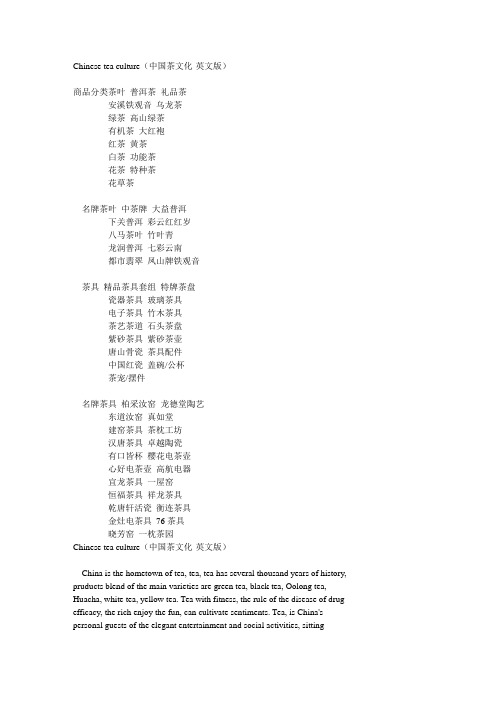
Chinese tea culture(中国茶文化-英文版)商品分类茶叶普洱茶礼品茶安溪铁观音乌龙茶绿茶高山绿茶有机茶大红袍红茶黄茶白茶功能茶花茶特种茶花草茶名牌茶叶中茶牌大益普洱下关普洱彩云红红岁八马茶叶竹叶青龙润普洱七彩云南都市翡翠凤山牌铁观音茶具精品茶具套组特牌茶盘瓷器茶具玻璃茶具电子茶具竹木茶具茶艺茶道石头茶盘紫砂茶具紫砂茶壶唐山骨瓷茶具配件中国红瓷盖碗/公杯茶宠/摆件名牌茶具柏采汝窑龙德堂陶艺东道汝窑真如堂建窑茶具茶枕工坊汉唐茶具卓越陶瓷有口皆杯樱花电茶壶心好电茶壶高航电器宜龙茶具一屋窑恒福茶具祥龙茶具乾唐轩活瓷衡连茶具金灶电茶具76茶具晓芳窑一枕茶园Chinese tea culture(中国茶文化-英文版)China is the hometown of tea, tea, tea has several thousand years of history, pruducts blend of the main varieties are green tea, black tea, Oolong tea, Huacha, white tea, yellow tea. Tea with fitness, the rule of the disease of drug efficacy, the rich enjoy the fun, can cultivate sentiments. Tea, is China's personal guests of the elegant entertainment and social activities, sittingteahouses, tea party are Chinese social groups tea activities. Chinese tea inthe world renowned, came to Japan in the Tang Dynasty, a Japanese tea ceremony.Chinese tea drinking began. Salt to boil the tea water, in accord with nature,Ya-drink taste for tea taste of the inherent lies mood, this is the tea of the characteristics of Chinese tea. The same quality of tea, such as differentwater, tea brewing technology different or mixed, bubble tea to have different results. China since ancient times was very particular about the tea brewing,and has accumulated rich experience. Bubble village, to understand the characteristics of various types of tea, the brew master of science technology,so that the inherent quality of tea can be fully demonstrated.Chinese tea, pay attention to a "goods". "Tea" is not only the identification ofthe pros and cons of tea, Shen Si with an unparalleled sense of taste and the taste of tea Italy. In his busy schedule of the counter; Nongcha a pot, of the Optional Yajing, Zizhenziyin, can eliminate fatigue, Si Yi Di trouble, be inspired, can also slow Chuo fine drink, to the enjoyment of the United Statesso that the spiritual world of sublimation To the lofty realm of art. Tea by the general environment of buildings, gardens, domestic furniture, tea wares, and other factors component. Tea requirements quiet, clean, comfortable, clean. China's world-renowned gardens, scenic landscapes is Bukeshengshu. Use of the natural landscape or garden, Erection teahouse, let people rest, Interest scene.China is an ancient civilization, Liyizhibang, heavy courtesy. Where to the guests, tea, Jingcha the etiquette is essential. When Youke visit, seeking an opinion, the choice of most visitors to taste the best tea and hospitality. Kingoff to tea, tea with the appropriate fight is necessary. In accompany guests tea masters, to the attention of the guests cups, pots of tea residue, the generaluse tea cup if he has to drink half, we should add boiling water, with the drink with Tim, the concentration of tea remained consistent , The water temperature appropriate. In tea may also be accompanied by appropriate Chasi, candy, food, taste and adjust to the dim sum effect.Chinese tea culture and the formation and developmentChina is the hometown of tea, is the world's first discovery of tea, tea and the use of tea cultivation countries. The origin of tea at least the main Qi Wannian history. Tea was found and the use of human, about Siwuqiannian history.The use of tea was first conceived in the wild collection activities. Legend hasit that ancient history "Shennong is Delicate Yuti, to lung liver five internal organs are reflected in its" on the grounds that "if not for Delicate Y uti,taste the medicine on the 1st event of 12 drugs, and why the solution of the«"another said" Shennong tasted Baicao, The case of 12 drugs, a Tu and solutions to. "Although the two can not be said to the letter, but a weak Lingpalygorskite information is noteworthy:" Tu "in the long process of consumption, people pay attention to some of its越来Treatment of the "medicine" by nature. This is a reflection of the times-Hong Huang Yi things.In accordance with "The Book of Songs" and other relevant documentation, in the pre-history, "Tu" refers to all types of wild plants bitterness of food raw materials. Fresh medical unity in the history of the times, the Zhike teavegetable oil, the Qing God, Xiaoshi, in addition to Zhang, medical function isto facilitate wait until it is not difficult for people found. However, thegeneral medical practices for the development of an exclusive drink often, there must also be some special factors, namely, real-life people in a particularneed. Bashu region, to the multiple for Jiyi "Zhang smoke" land. "Barbarian people living with tea, the lack of will." (Ai Qing weeks of "Zhu Guo Travels" Volume II) is often vulgar Bashu people eating spicy side, thousands of habit, still. It is this natural geographical conditions and the resulting decision ofthe people's dietary practices, making Bashu people first "JIANCHALING" Apart from taking to Zhang Qi, antipyretic drugs. Jiufu-Xi, a medicinal purpose gradually Subduction, tea has become a daily drink was. Qin-Ba-Shu, is likely to see this as a daily drink tea customs.Tea from medicinal drink into a regular habit, the strict sense of "tea" wouldthen have its typical signs that "tea" (cha) the emergence of sound. Guo Pu Note "Yi-release", "Jia": "small trees such as gardenia, Dong-Sheng Ye, can be boiledfor soup to drink. As early as today called for the mining, tea, who wasadmitted late Ming, a Chuan, Shuren of the TU. "Clearly, the Han," Tu "has been specifically beverage word" tea "in pronunciation," tea "from" Tu "isolated, and embarked on the" independence "road of development. But "tea" the emergence of the word is accompanied by the development of the tea things and commercial activities have become increasingly frequent, until later in the Tang Dynasty,is also in line with the new symbol of a people's social life after such a text change in the law.China will start from the tea, There are different theories about, the WesternHan Dynasty, tea drinking has been a matter of the official literature, drinkingtea when the starting time earlier than some. Tea appears to cultural characteristics, in the Han, Wei and Jin Dynasty, Northern and Southern Dynasties period.Tea Culture Broadly speaking, the tea at the natural sciences and humanities teain terms of both human society is in the process of historical practice ofcreating and tea-related material and spiritual wealth combined. In a narrow sense, focusing on the human sciences tea, tea mainly refers to the spiritualand social functions. As the science of tea has become an independent system,which now often say the tea culture emphasis on the humanities.▲ the three countries before the tea culture of the EnlightenmentMany of the books found that the tea set for 2737-2697 BC, its history can be pushed to Sanhuangwudi. Eastern Han Hua, "The Fresh": "Kucha for food, meaning benefits" of the medical records of the value of tea. Western Han Dynasty tea tothe county of origin named "Tu-Ling", that is, Hunan Chaling. To San Guowei generation "-Blair" has the earliest documented the method of tea cakes and drinking: Story of the Pakistani Inter-for cake, pie-old man leaves to a pasteof rice. Tea in the form of material and infiltration to other human sciencesand the formation of tea culture.▲ Jin Dynasty, the seeds of the Northern and Southern Dynasties tea cultureWith the rise of the literati tea, the tea poetry Gough increasingly available,tea has been out as a general form of eating into the cultural circles, willplay the spirit of social role. Jin Dynasty, Northern and Southern Dynastiesperiod, Menfa system has been formed, not only the emperor, nobility amassed a wave of officials and scholars generally皆以Doo-ho proud boast, multi-effect Plaster Liang Hou Wei. In this case, some people of insight to "Yang Lian."Thus, there is satisfied that the land, Huanwen to tea and wine at all. South Qishizuwu emperor is a relatively enlightened emperor, he did not Hei Y u Yan, under Yi Zhao before his death, he said after the funeral to be thrifty aspossible, not to Sansheng for offerings, only put more Ganfan, fruit cake and Chafan can. And to "the world Guijian, with such a system." Satisfied that theland, Huanwen, Emperor Wu Qi, where tea is not only refreshing to quench their thirst, it began work in a community, into a tea hospitality, to worship andthat a Kind of spirit and sentiment of the means. Tea has not entirely the useof its natural value used by the people, but entered the spirit of the area.Wei, Jin and Southern and Northern Dynasties period, the world disorder, allkinds of ideological and cultural exchanges collision, supernaturalism very popular. Metaphysics is the period of the Wei, Jin, a philosophical ideas,mainly糅合Confucian thinking of the Lao Zi and Zhuang Zi-yi. Xuan Xuejia most of the so-called Fellows, the first to the door, the face, the instrument only,Hyun-loving nothingness from the light. Eastern Jin Dynasty, furans North Korea,the affluent Kangnam Scholars to be temporary to meet, hang around all day in Qingshanxiushui between the light winds to continue to develop, resulting inmany light home. Initially there are more than idle talk Jiutu home, and later,talk of the wind gradually developed to the general literati. XuanxueJia-speech, also general-talk rhetoric. Liquor make people excited, but drinkingmore would be stricken manner, nonsense, failed Yaguan. The tea-drinking and may be Jingri always clear, it is clear thinking, calm attitude. Moreover, thegeneral terms of the literati, the whole day dealing with Jiurou, of theeconomy, will not allow. Days, many Xuan Xuejia, talk to wine home from the village. In them, where tea has been treated as a mental phenomenon.With Buddhism, Taoism up, and have tea and Buddhism, Taoism linked. In Taoism, the tea is to help Lian "inner alchemy" or-down muddy, light-weight-for-bones,Xiu Changshengbulao a good way to the body in Buddhism, the tea is a brooding meditation required of Of the show. Although this has not yet formed a complete religious tea ceremony and the ideological principles set out tea, but tea hasbeen divorced from the diet as a form of state, has significant social, cultural functions, the Chinese tea culture初见clues.▲ th e formation of the Tang Dynasty tea culture780, Lu Yu, "the tea," tea culture of the Tang Dynasty is a landmark. Tea has summed up its natural and human sciences double content of the tea arts, Confucianism, Taoism, Buddhism into the three tea, the pioneering spirit of the Chinese tea ceremony. After tea and a large number of books, poems tea, "tea in", "JIANCHALING water", "Cai Cha", "16 soups." Tang tea culture and the formation of the Zen on the rise, the benefits of tea is refreshing thought, spermatogenic Zhike function, the temple advocates tea, tea trees planted around the temple, the development of the tea ceremony, a tea appear, the firstelection of tea, The matter was tea activities. China's Tang Dynasty in the formof tea ceremony at the palace tea, the tea ceremony of the temple, the literatitea ceremony.▲ the prosperity of the Song Dynasty tea cultureSong tea has been a great development, and promote the development of the tea culture, the literati in a professional Tea Associations, an official of the"social soup", a Buddhist, "1,000 clubs." Song Taizu Zhao Kuangyin tea is a嗜of disabilities, in court and authorities in the establishment of tea things, thecourt has been using tea grades. Tea-ceremony system has become, thanks to win over Secretary of tea has become the emperor, with relatives眷an important means, but also give foreign envoys. As for the lower social and vitality of teaculture is more lively, some of movement, the neighbourhood to "Xiancha" You Ke, to respect the "gold ingot tea", when engaged to "tea", the time of the marriageto "the tea", when roommate "A tea." Cha Doo civil wind, has brought Preparing cooking point of a series of changes.Since the Yuan Dynasty, the tea culture has entered a period of twists andturns. Song expansion of the tea culture and the social dimension of cultural forms, tea things are booming, but the tea to complicated, trivial, luxury, lostthe Tang Dynasty tea culture profound ideological connotation, too delicate tea flooded the spirit of the tea culture, lost Its noble profound nature. In court, nobles, scholars there, drinking tea became a "drink at the child" and "drinking style," and "Play tea."Mongol Yuan Dynasty into the Central Plains, the Chinese nation marks the full integration greatly accelerate the pace. On the one hand, although the northern ethnic minorities like tea, but mainly out of life, physical needs, from theculture it has Tea Zhu Ming Fun little things give the other hand, the subdued broken the face of Han culture, Ethnic oppression, but also inadvertently teathing again to express their Merry Ti Tang, and hope that through the performance of their sentiments tea, Grounding their will. These two different ideological trends in the tea culture in the Agreement, to promote the tea tothe simple, Fanpuguizhen direction. Before the middle of the Ming Dynasty, theHan Chinese Thoughts on behalf of the former national cite death, the Jufounding a state is difficult, therefore still with Li Festival at all. Teaculture is still potential for the Yuan Dynasty, the performance for thesimplicity of tea, tea culture and the natural fit fine candy, tea to the plightof their performance.▲ that the universal culture of Qing-ChaAt this point there has been steaming green, Chaoqing, Hong Qing, and other tea,tea drinking has been changed to "minority bubble", many of the Ming Dynasty scholar Aston handed down the left for, such as snowster "Pengcha picture," "Tea map ", Wen Zhengming's" Huishan tea party "," Lu Yu Pengcha plans, "" Tea plans. " The increase in tea, tea art are different, the style of Tea Ware,texture, pattern Qianzibaitai. Tea exports to the Qing Dynasty has become one ofthe official sector, the tea, tea, tea countless poems.▲ the development of modern tea cultureAfter the founding of New China, China's annual output of tea from 1949 to 7500T development in 1998, more than 60 million T. Tea a substantial increase in material wealth for the development of China's tea culture to provide a solid foundation in 1982, set up in Hangzhou, the first to promote tea culture for the purpose of social groups - the "tea house", established in 1983 in Hubei " Lu YuTea Culture Research Society, "1990" were the Federation of Chinese tea "was setup in Beijing, 1993," the China International Tea Culture Research Society "inthe establishment of Island Lake, in 1991 China Tea Museum in Hangzhou West Lake Township officially opened. 1998 China International Tea Cultural Exchange Peace Museum completed. With the rise of tea culture and tea houses throughout the run more. International Tea Culture Symposium has been opened to the fifth sector,has attracted Japan, South Korea, the United States, Sri Lanka and Hong Kong and Taiwan have participated. The main provincial cities and counties in the tea production in the host "Tea Day", such as Fujian's Wuyi Yancha section of thecity, Yunnan's Pu'er tea festival, Zhejiang Xinchang, Taishun, Hubei and Britain Hill, the Tea Festival in Xinyang, Henan abound. To have tea as the carrier, to promote comprehensive economic and trade development.In short, the history of Chinese tea and its development, not just a simple diet of a cultural process, and mapping out the same from top to bottom with a 5,000-year history of the nation's ethosChina's largest tea Monopoly Web site: 新手上路。
- 1、下载文档前请自行甄别文档内容的完整性,平台不提供额外的编辑、内容补充、找答案等附加服务。
- 2、"仅部分预览"的文档,不可在线预览部分如存在完整性等问题,可反馈申请退款(可完整预览的文档不适用该条件!)。
- 3、如文档侵犯您的权益,请联系客服反馈,我们会尽快为您处理(人工客服工作时间:9:00-18:30)。
思考·探索
郑玉美
(河南应用技术职业学院,河南 郑州 450042)
摘 要:茶名是茶文化中一个独特的艺术领域。本文从翻译目的论出发,针对中国茶叶分类及命名,对直译、音译、意译和注释 等茶名英译方法进行探索,以促进中国茶文化的有效译介和传播。
关键词:茶文化;目的论;茶名;英译
中国是茶叶和茶文化的故乡。在悠久的中国茶文化中,由于茶名 种类繁多,茶名英译中出现了音形相同本质不同、错误关联、一茶多 译及茶名无“茶”等诸多不规范的翻译问题,致使茶名英译极不统一 和不规范。因此,作为对外文化交流的重要一环,中国茶叶名称翻译 亦显得非常重要。本文拟从翻译目的论出发,对中国茶文化中的茶名 英译的问题进行探索。
1 翻译目的论
德国功能派目的论主张,在对茶名进行英译时,一是译者要明确 茶名英译的首要目的,是用英语把中国茶名包含的中文内涵传达出 来,并实现这一特殊的“交际目的”;二是面向译入语目标文化受众和 递目的;三是译者对源语言和目标语言的语体风 格与规范要熟悉。
2 中国茶叶分类及命名
中国地大物博,根据茶叶加工制作方法,中国茶叶常被分为绿 茶、红茶、青茶、黄茶、白茶和黑茶六大类。在这六大类下面,又分为各 种不同的茶,其命名规律也各不相同。茶名是中国茶文化中一个独特 的艺术领域,它不仅将茶叶自身的形、色、香、味、产地等特点艺术性 地融合在一起,还集中传达了中国传统的审美观点、地理历史和乡土 习俗等文化观念。
在直译茶名的同时并加以文内注释,既可以通过直译保持原作 精髓和文化特色,同时通过注释向译入语读者解释源语的特有内涵
基金项目:2016年度河南省社会科学普及规划项目“郑州市汉英公示语翻译普及读物”;2017年度河南省人文社会科学研究规划项目“郑州市公示 语汉英翻译问题及对策研究”。 作者简介:郑玉美 (1975-),女,河南濮阳人,硕士,讲师。研究方向:英语语言学、英语阅读及中西翻译比较。
直译和音译虽保留了源语文化信息,但对译入语读者来说其翻 译出的文化含义不易理解接受;同时,直译和音译并非适用于所有茶 名的翻译,对于极具中国特色文化意象的茶名在英译时,可舍弃源语 表达形式,选择意译把茶名的内涵意义翻译出来。如“云腴”指白色的 肥壮的芽叶,若直译为 yunyu 或者直译为 fat cloud,均丧失了“云腴” 一词在汉语中的文化意蕴,故只能意译为 white buds。另外,“青沱 ” 被意译成 Age Bowl Puer,传达了“普洱生茶”的涵意;“熟饼”被意译 成 Pile Cake Puer,传达了“普洱熟茶”的涵意。 3.4 注释法 3.4.1 直译加注释
从古至今,很多茶叶在文人笔下演化出诸如“瑞草魁”、“仙芝”、 “明月寮”等充满诗情画意的高雅称谓。这些未见其茶、先闻其名的优 美绮丽称谓,让人一股美感由心而生。英译这类茶名时,想要保留原 名中的美妙意象,可采用直译法将中华民族尚美求雅的审美习惯传 达到英语译文中。如“瑞草魁”Queen of Blessed Grasses、“仙芝”Fairy Grass、“明月寮”Bright moon House 等。 3.2 音译法
翻译知名的茶叶时,在英语中如果没有对应的英文单词,可采用 “汉语拼音 +tea”的形式进行音译。如屡次被评为“中国十大名茶”的 “龙 井 ”Longjing Tea、“碧 螺 春 ”Biluochun Tea、“ 铁 观 音 ”Tieguanyin Tea 等在国内外具有一定知名度的茶叶,采用音译是其最佳翻译方 式。对于“产地 + 品种”形式的茶叶,也可使用音译法,如“太平猴魁” Taiping Houkui Tea (产自 安 徽 省 黄 山 市)、“庐 山 云 雾 茶 ”Lunshan Yunwu Tea、“ 黄 山 毛 峰 茶 ”Huangshan Maofeng Tea、“ 信 阳 毛 尖 茶 ” Xinyang Maojian Tea 等。但对在国际市场上没有知名度的茶叶是不 适合采用音译的。
3 茶名英译方法
3.1 直译法 “当源语和目的语受众的认知环境几乎没有差异,并且对商品名
称的认知角度、消费观念、价值取向等趋于一致时,译者可以采用直 译”。大多数中国茶叶名称英译时都可采用此种方法。
对 于 以 形 色 味 命 名 的 茶 叶 ,采 用 直 译 法 进 行 翻 译 ,可 保 持 茶 叶 原名精髓。如“雀舌”Sparrow Tongue,“鸟嘴”Bird Beak,“蝉翼”Ci原 cada Wing,“眉茶”Eyebrow Tea 等,由于其集中体现了中国传统审 美 观 中 鲜 明 比 喻 形 象 特 点 ,采 用 直 译 ,既 保 留 了 形 象 生 动 妙 趣 横 生 的艺术韵味,也对外国受众介绍了中国独特的审美情趣。“红茶”的 英译是“black tea”而不是“red tea”,这是因为早在 17 世纪,英国开 始 在 中 国 大 量 收 购 福 建 武 夷 茶 ,因 其 茶 色 为 黑 ,所 以 直 译 为“black tea”,后 来 茶 学 家 根 据 茶 的 制 作 方 法 和 茶 的 特 点 进 行 归 类 ,武 夷 茶 冲 泡 后 红 汤 红 叶 ,按 其 性 质 属 于 红 茶 类 ,但 由 于 英 国 人 已 经 习 惯 称 武夷茶为“black tea”,所以这一约定俗成的说法就一直沿袭下来,以 指代红茶。
音译出来的英语词汇,应遵循术语的属性要求。其中重要的一点 就是系统性,即具有构成相关术语词汇的能力。从英语术语的这一要 求来看,Puer tea(普洱茶)是一个值得推广的音译词[4]。它形式简单, 比较符合英语词形,又容易构成一系列衍生词汇,如“生普洱”raw Puer、“熟普洱”cooked Puer、“陈年普洱”aged Puer、“大叶普洱”largeleaf Puer 等。相比之下,“铁观音”的音译词 Tie Kwan Yin 和意义词 iron goddess of mercy oolong 都不太具有生成系列词汇能力,对其翻 译放弃与茶树及与观音有关的传说,直接采用汉语拼音 Tie guanyin 可能更好。 3.3 意译法
